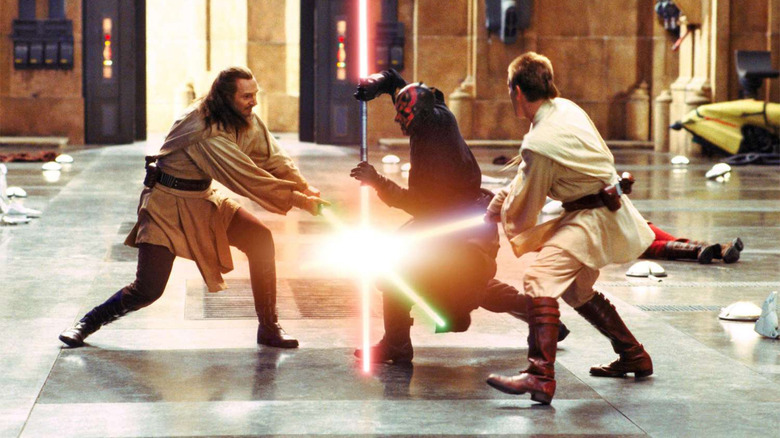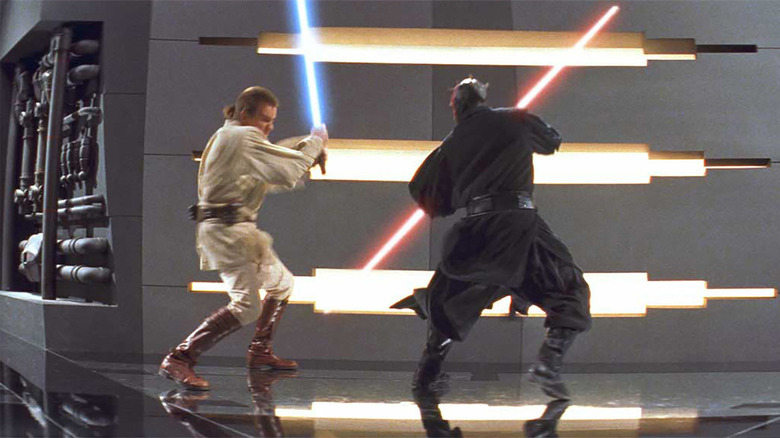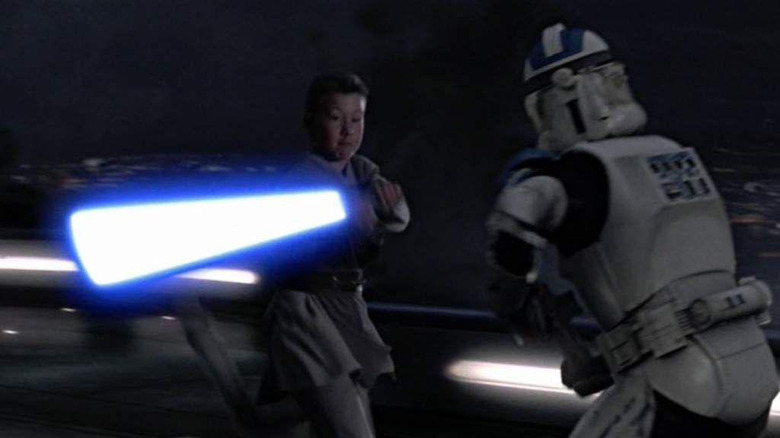Star Wars' Phantom Menace Lightsaber Fight Was Decided By A Five-Year-Old
Back in 2018, "Dune" director Denis Villeneuve threw "Star Wars" fans into a tizzy (it doesn't take much these days) when he described his then-upcoming adaptation of Frank Herbert's seminal sci-fi novel as being like "'Star Wars' for adults." Of course, that's not really an insult to the franchise or its fans, because "Star Wars" creator George Lucas made no secret of the fact that "Star Wars" is intended for kids.
In fact, during a surprise appearance at Star Wars Celebration in 2017, he reiterated that the very first "Star Wars" installment, which would go on to be titled "A New Hope," was a "a film for 12-year-olds." Of course, that doesn't mean adults can't still find value in these sci-fi stories of heroism. But it also means that the franchise, from its inception, has always been molded to be appealing to children.
Therefore, it should come as no surprise that when Lucas got around to making "The Phantom Menace," kicking off an entire prequel trilogy about how Anakin Skywalker became Darth Vader, the filmmaker entrusted the approval of one of the most pivotal parts of the movie to a five-year-old kid. When the iconic "Duel of the Fates" lightsaber battle between Qui-Gon Jinn, Obi-Wan Kenobi, and Darth Maul was being developed by stunt coordinator Nick Gillard, it needed the seal of approval from one very specific child.
Phantom Menace's lightsaber battle sparks a new kind of martial art
As Gillard recalled in a deep-dive into the making of "The Phantom Menace" lightsaber battle at Vulture, "George has never been in a fight in his life. So he didn't bother, really, writing it. It would say something like, 'A vicious lightsaber battle ensues — seven minutes,' and you could fill in the gap there. But that's much better for me."
Up until this point, the lightsaber fights in "Star Wars" hadn't exactly delivered fast-paced sword combat. Instead, much of the original lightsaber duels were inspired by elegant fencing techniques. Though Luke Skywalker's style in "Return of the Jedi" is a little more energetic and chaotic, fueled by his anger as he faces his father, Darth Vader, the rest of the battles are patient, calculated, and slow. That's why Gillard completely ignored those lightsaber battles when it come to creating the two-on-one fight in "Phantom Menace." As Lucas recalled in a behind-the-scenes documentary, "I thought I wanted a faster version of what the other movies were; a more energetic version; and that's basically what he gave me."
In fact, Lucas had instructed Gillard to "come up with a new kind of martial art," which the stunt coordinator described as "an amalgamation of all sword fighting." Kendo, rapier, samurai, and a little bit of tennis and even chopping down trees informed the rapid battle between the two Jedi and the Sith apprentice. All of this combined to give each of the warriors a level of mastery in wielding a lightsaber where everything had to be precise as well as fast. Gillard added, "They can only parry there, they can only attack there. The moves are so natural or so correct, that's the only place they can be."
Armed with his new approach to lightsaber fights, Gillard took three days, a small camera crew, and a trio of stuntmen to shoot test footage that would be used to get approval from George Lucas. Among those stuntmen was none other than Ray Park, suggested by a friend of Gillard who worked with the stuntman on "Mortal Kombat."
But when the time came to show off the test footage, George Lucas wasn't the only person they needed to impress.
The rise of Jett Lucas
Gillard put together a five-minute demo reel showcasing the new lightsaber fighting style for George Lucas to see. Lucas, again believing that the "Star Wars" movies are for kids, played the test footage for his five-year old son Jett Lucas. As Gillard recalled to Entertainment Weekly, "Effectively, Jett Lucas decided the style of that fight."
Jett Lucas was apparently impressed by what he saw, and the rest is history. The lightsaber battle itself would take two months to complete, mostly because production wanted to make sure actors Ewan McGregor and Liam Neeson did as much of the lightsaber battle as they could, rather than relying on stunt doubles. A lot of time was spent getting McGregor and Neeson up to speed, so they could keep up with Ray Park, who was so impressive in the test footage that he landed the role of Darth Maul (though his voiced would be dubbed by Peter Serafinowicz in post-production).
Funnily enough, Jett Lucas would get one more pivotal lightsaber moment of his own in the actual canon of the "Star Wars" universe. In "Revenge of the Sith," the son of Lucas had a brief appearance as a Jedi padawan named Zett Jukassa, who is fighting off Clone Troopers during the Order 66 attack on the Jedi Temple. Unfortunately, he's eventually taken out by one of their blasters. You can also see Jett Lucas as the same character in "Attack of the Clones," appearing briefly behind Jedi archivist Jocasta Nu when she chastises Obi-Wan Kenobi for suggesting the archives were incomplete (even though he was right).
So Jett Lucas went from determining the style of the lightsaber duel in "The Phantom Menace" (which Lucasfilm's chief creative officer Dave Filoni believes to be the most important moment in the prequel trilogy) to wielding a lightsaber of his own, and all he had to do was be the son of George Lucas to do it.


